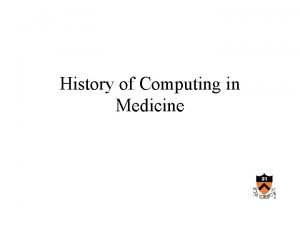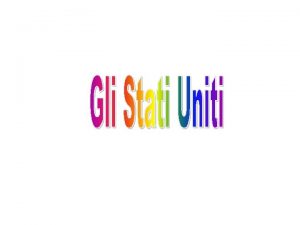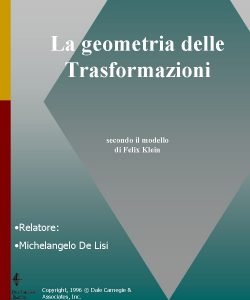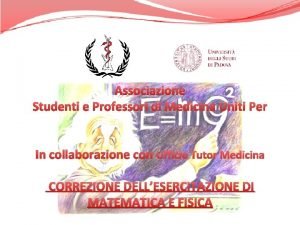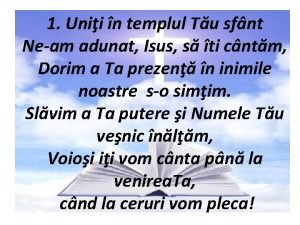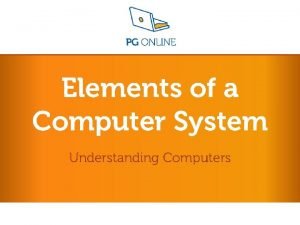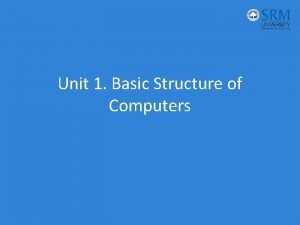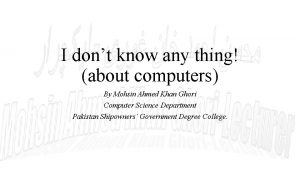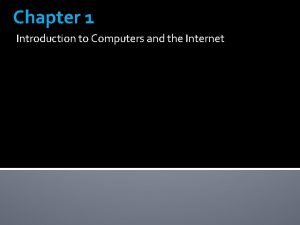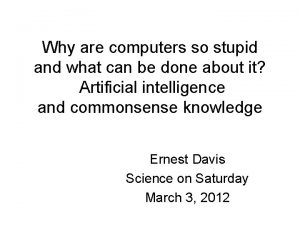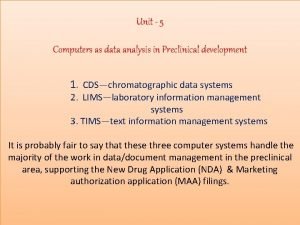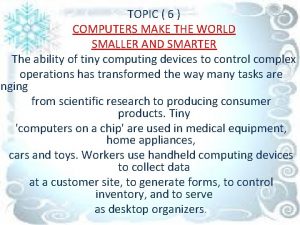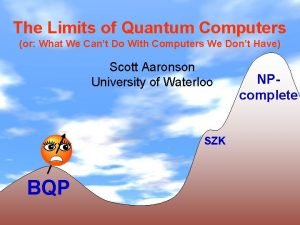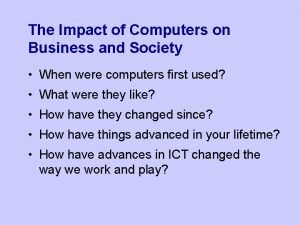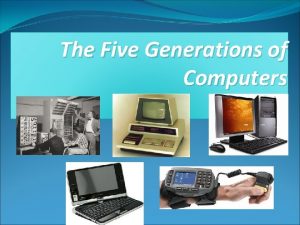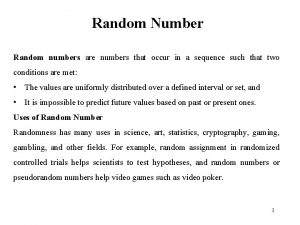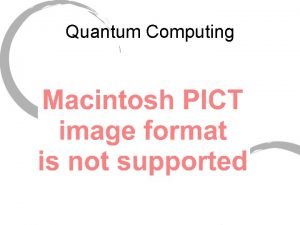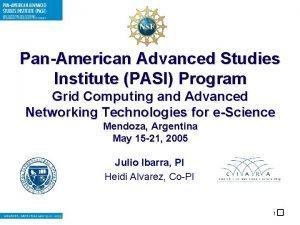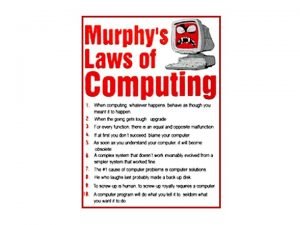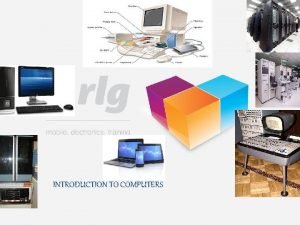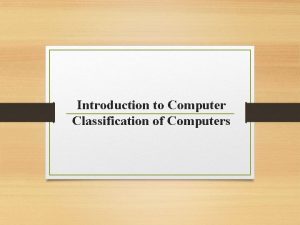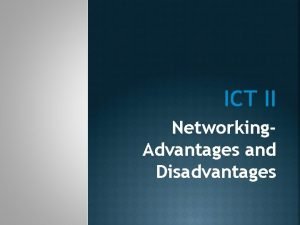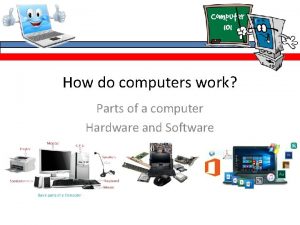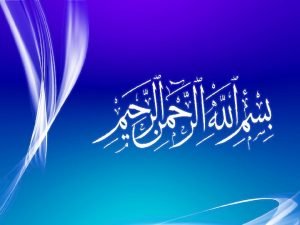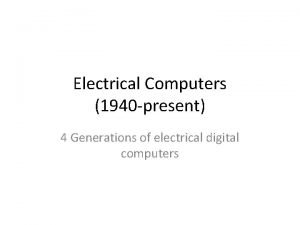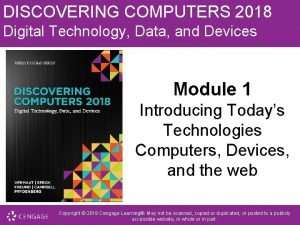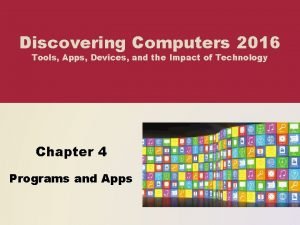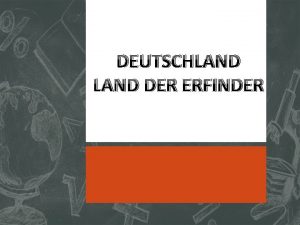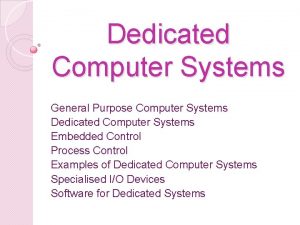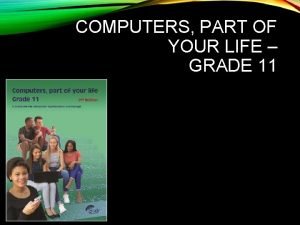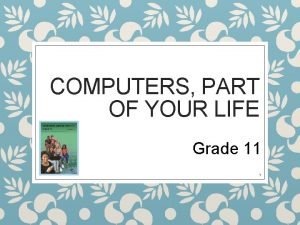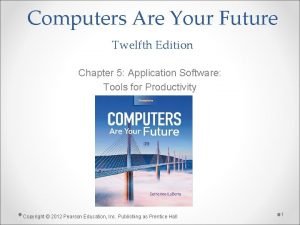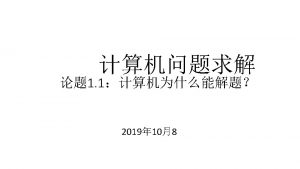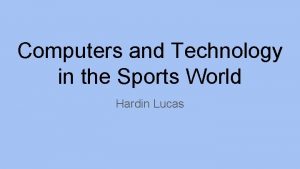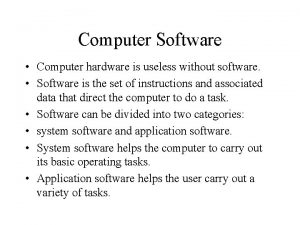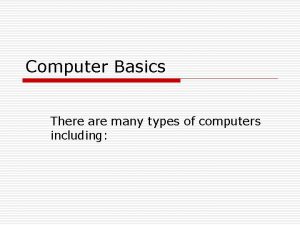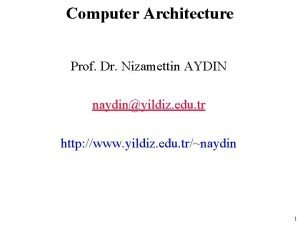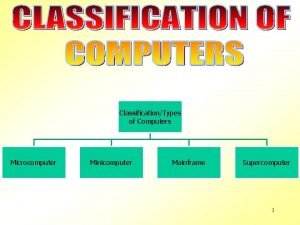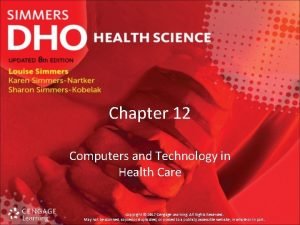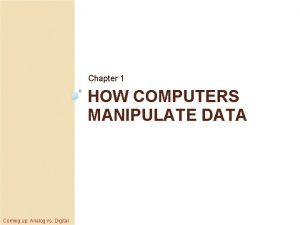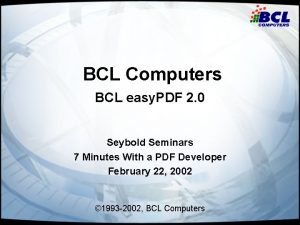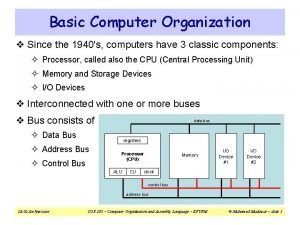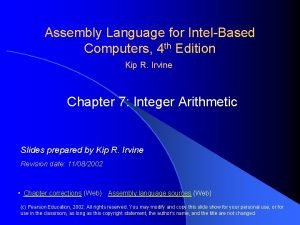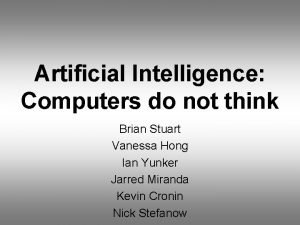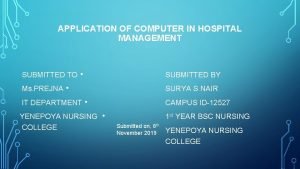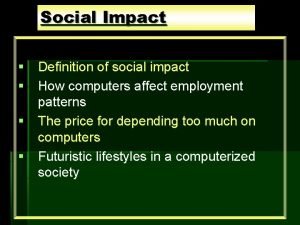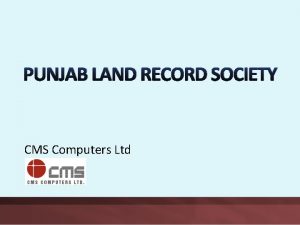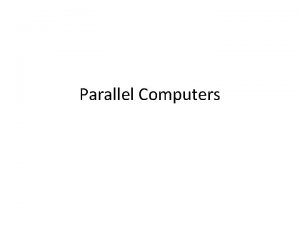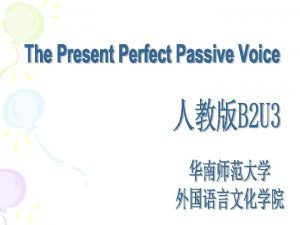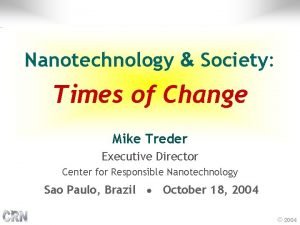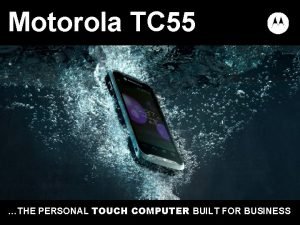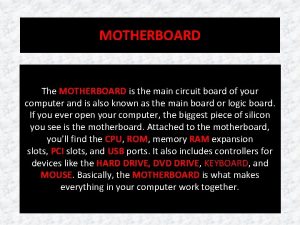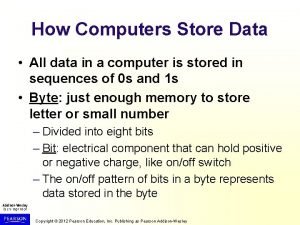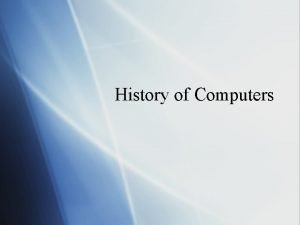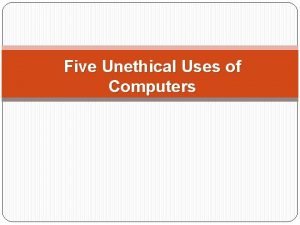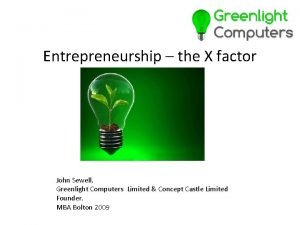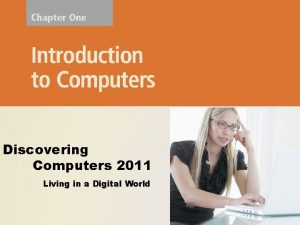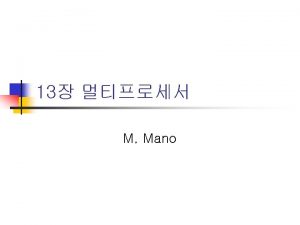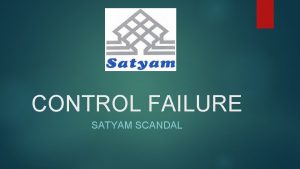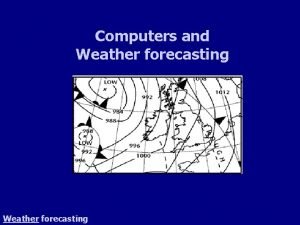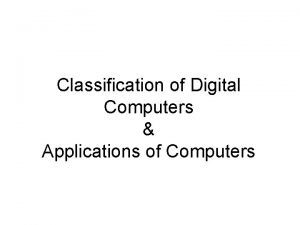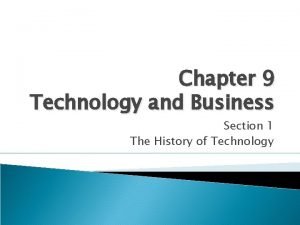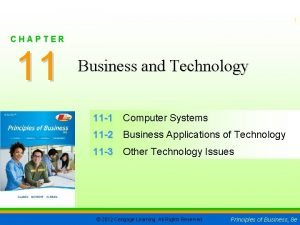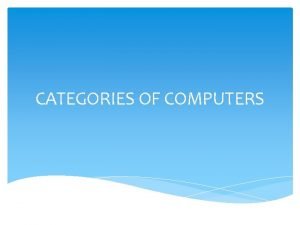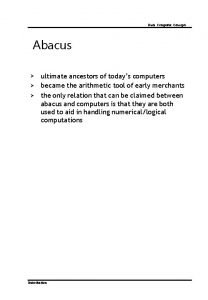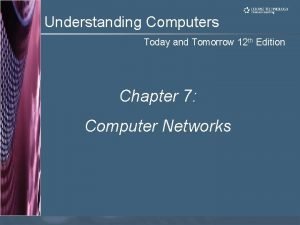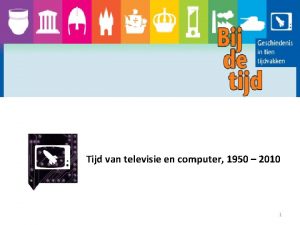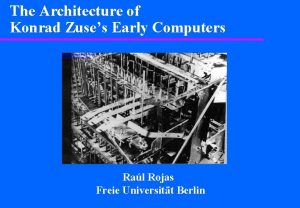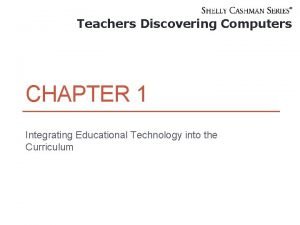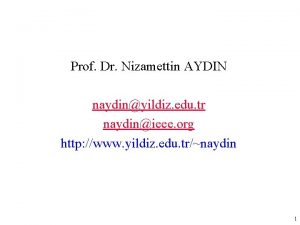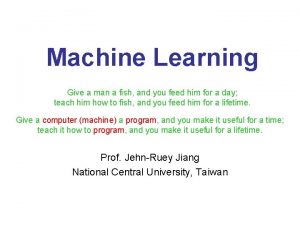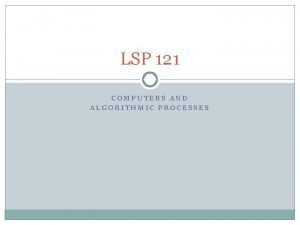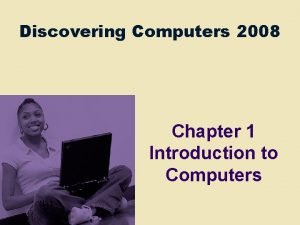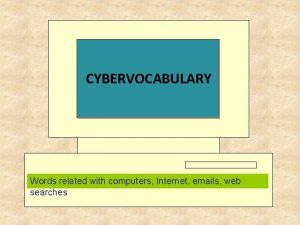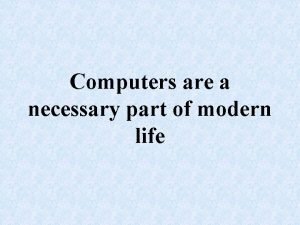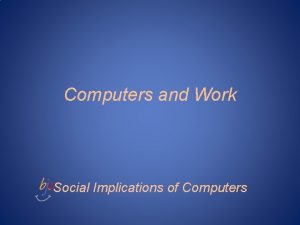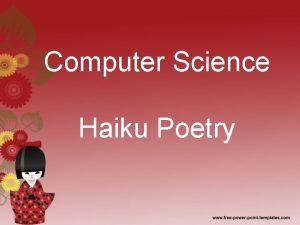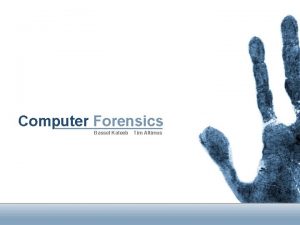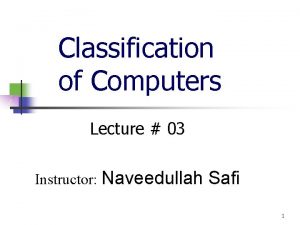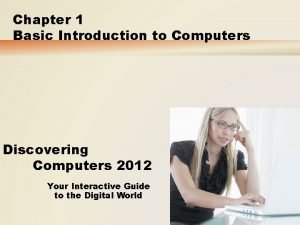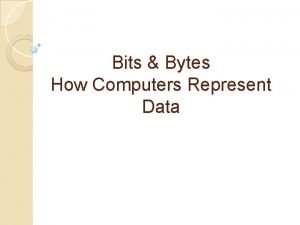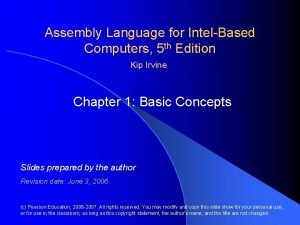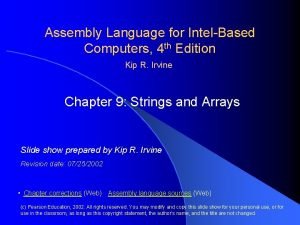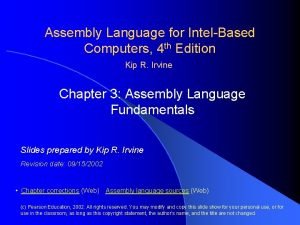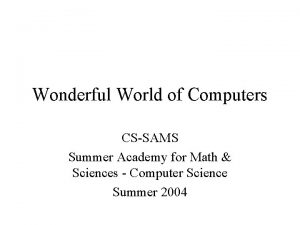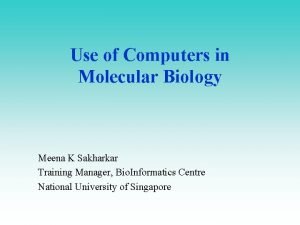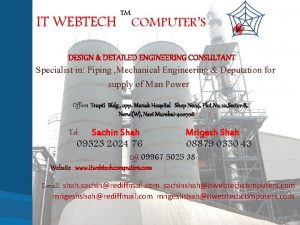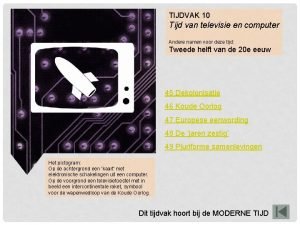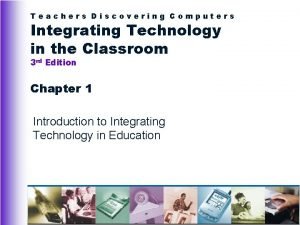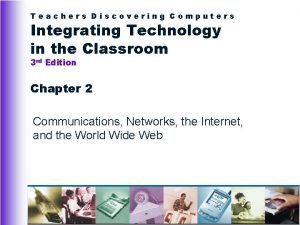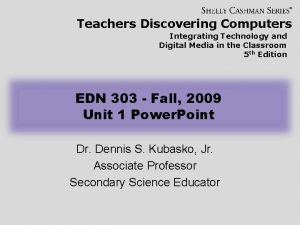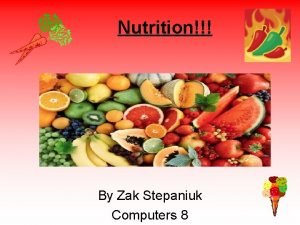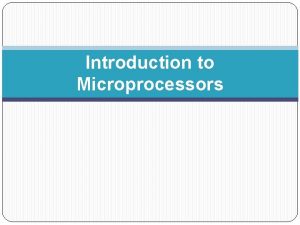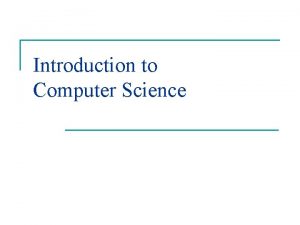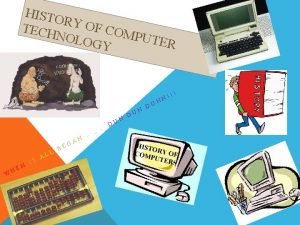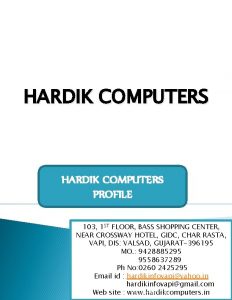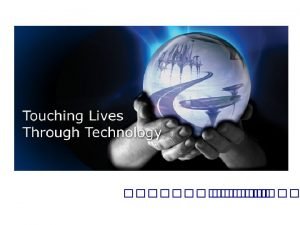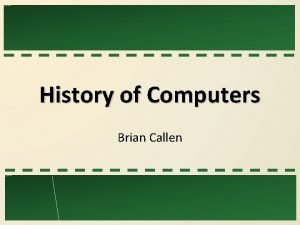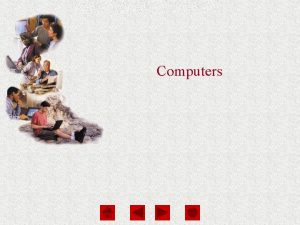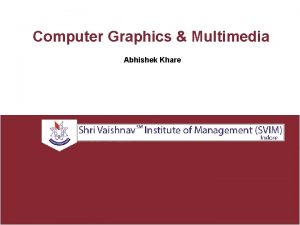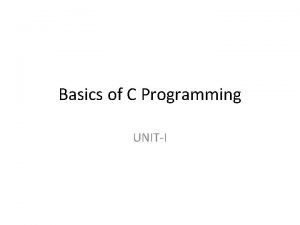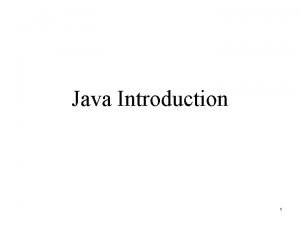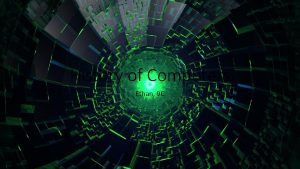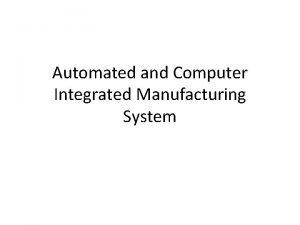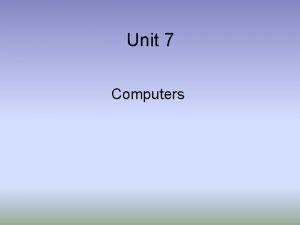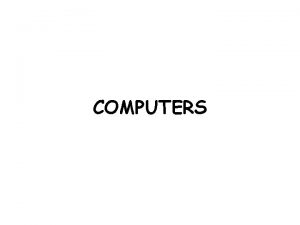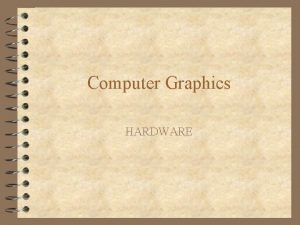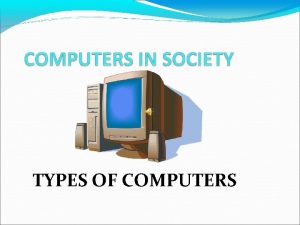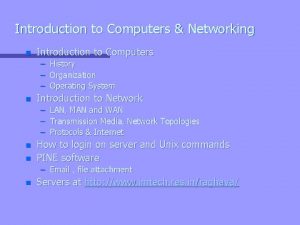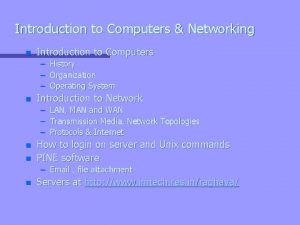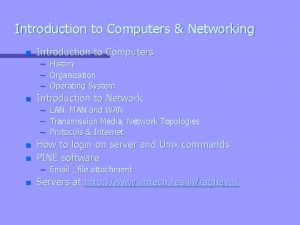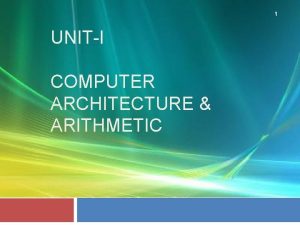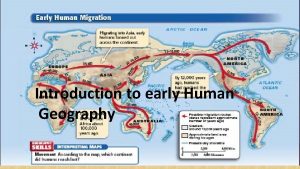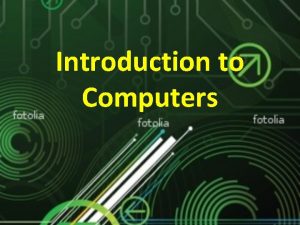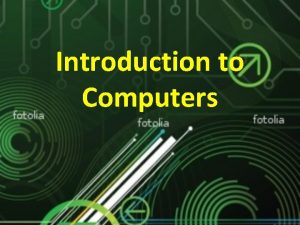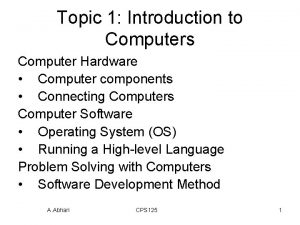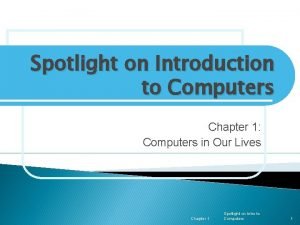UNITI Introduction To Computers Introduction to Computer Early









































































































- Slides: 105

UNIT-I Introduction To Computers

Introduction to Computer • Early days people use fingers for computing purpose. • As years go, the computing needs also grew. This leads to the invention of calculators and computers. • The term computer is derived from the word compute, it means to calculate.

Definition • Computer is an electronic device. It accepts data, process the data and gives the desired output. INPUT COMPUTER OUTPUT

Basic functions or operations • • • Input Processing Output Storing Controlling

Basic operations (Cont) • Input It is the process of getting the data from the user or from somewhere else into the computer to process. • Processing It is the process of converting the input to output.

Basic operations (Cont) • Output It is the outcome or result of the process. • Storing It is the process of saving the data. so that it can be retrieved whenever needed.

Basic operations (Cont) • Controlling It is the process of directing the sequence in which the operations to be performed.

Applications of computer: • • • Business Industry Home Education Printing & publishing Entertainment etc. ,

CHARACTERISTICS OF COMPUTER

CHARACTERISTICS OF COMPUTER • • • Speed Accuracy Diligence Versatility Reliability Storage

CHARACTERISTICS OF COMPUTER (cont) • Speed The computer process the data extremely fast. (i. e. ) in millions (1, 000) of instructions and even more per second. A computer can perform a huge task in few sec where a human being may take hours or even days to complete the same task.

CHARACTERISTICS OF COMPUTER (cont) • Accuracy The degree of accuracy of computer is very high and every calculation is performed with the same accuracy. The accuracy level is determined on the basis of design of computer. The errors in computer are due to human and inaccurate data.

CHARACTERISTICS OF COMPUTER (cont) • Diligence A computer is free from tiredness, lack of concentration etc. It can work for hours without creating any error. If millions of calculations are to be performed, a computer will perform every calculation with the same accuracy. Due to this capability it overpowers human being in routine type of work.

CHARACTERISTICS OF COMPUTER (cont) • Versatility It means the capacity to perform completely different type of work. For example At a moment a computer can be used to draft a letter. Next moment it can be used print a document or play a music file etc. ,

CHARACTERISTICS OF COMPUTER (cont) • Reliability It produces results without any error. Only human made errors can occur So they are trustworthy machines.

CHARACTERISTICS OF COMPUTER (cont) • Storage Computers are capable of storing huge amount of data and it can be located and retrieved very quickly. It uses storage devices such as hard disk to store huge amount of data.

Generations of Computers

Generations of Computers (Cont) First Generation Computers(1940 -1956): • These computers were vacuum tube based machines. • They used magnetic drums for memory. • Input were fed into the computer using Punched cards • The size of these computers were very large and it produce more heat. • They lacked in versatility and speed. • They were more expensive.

First Generation Computers(1940 -1956): • Speed: Fastest computing device of its time • Technology: Vacuum Tubes : – Made up of glass contains filaments, when heated generates electrons which helps in amplification and de amplification of signals • I/p & O/p : Punched card and print out • Programming language: Machine level language • Example: – EDSAC: Electronic delay storage automatic calculator – EDVAC: Electronic discrete variable automatic computer

First Generation Computers(1940 -1956): • Advantages: – Fastest computing device of their time – Execute complex mathematical problems in an efficient manner • Disadvantages: – – – Large & Bulky Difficult to program Cannot be transferred from one place to another These are special purpose computers Generates huge amount of heat and hence prone to hardware faults

Generations of Computers (Cont) Second Generation Computers (19561963) • Here the Transistor replaced the bulky vacuum tubes. • Transistors are smaller than vacuum tubes and have higher operating speed. • Thus the size of the computer got reduced considerably. • Manufacturing cost was also very low.

Second Generation Computers (1956 -1963): • Speed: Faster than first generation • Technology: Transistor : – Used to increase the power of incoming signals. – It has 3 connections: • Base : Through which incoming signals are sent • Collector : Collects amplified signal • Emitter : Emits amplified signal • I/p & O/p : Punched card and print out • Programming language: Assembly language • Example: – IBM 1401 – IBM 1620

Second Generation Computers (1956 -1963): • Advantages: – – – Fastest computing device of their time Easy to program Light weight Low power consumption Low maintenance Transferred from one place to another easily • Disadvantages: – High cost – Limited to special purpose tasks – Generates considerable amount of heat

Generations of Computers (Cont) Third Generation Computers (1964 -1975) • These computers were based on Integrated Circuits (ICs) Technology. • A single IC has many transistors, registers and capacitors built on a single thin slice of silicon. • So that the size of the computer got further reduced. • These Computers were small in size, low cost, large memory and processing speed is very high.

Third Generation Computers (1964 -1975): • Speed: Fastest computing device of its time • Technology: Integrated Circuits : Also known as micro electronics technology • Programming language: High level language • Example: – IBM 360 – Honeywell 6000

Third Generation Computers (1964 -1975): • Advantages: – – – – Computational time was measured in nano seconds Requires low power to operate Small size Installation is very easy Able to execute any type of applications More reliable & requires less maintenance Easily transportable • Disadvantages: – – Storage capacity was very small Performance will get degrade while executing large applications Cost is very high Required to be placed in air conditioned plates

Generations of Computers (Cont) Fourth Generation Computers(1975 -1989) • It uses very large scale Integrated Circuits (VLSI) built on a single silicon chip called microprocessors. • These computers are called microcomputers. • Thus the size of the computer got reduced. • The personal computer (PC) are comes under the Fourth Generation.

Fourth Generation Computers (1975 -1989): • Speed: Fastest computing device of its time • Technology: VLSI : Very large scale Integration – It leads to the development of GUI, Operating Systems, Various storage devices, I/O devices and LAN – It has 3 components: • Microprocessors • Memory • I/O Controls • Programming language: High level language • Example: – IBM PC series – Apple Series

Fourth Generation Computers (1975 -1989): • Advantages: – – Very powerful in terms of speed & time Storage capacity is very high & it is very fast Highly reliable and requires low maintenance Provides user friendly environment using GUI(Graphical user interface) – Programs are highly portable – Highly versatile and requires less power • Disadvantages: – The soldering of VLSI chips on the wiring board was not an easy task – Working of these computers depends on instructions given by the programmer

Generations of Computers (Cont) Fifth Generation Computer(1989 -Till date) • The speed is extremely high in fifth generation computer. • The concept of Artificial intelligence has been introduced to allow the computer to take its own decision. • It is still in a developmental stage.

Fifth Generation Computers (1989 -Till date): • Speed: Faster of all times • Technology: ULSI : Ultra large scale Integration – It has more than 10 million electronic components – It increases the power & speed of the microprocessor • Programming language: – High level language – Integrated development environment • Example: – Laptop – PDA

Fifth Generation Computers (1989 -Till date) • Advantages: – – – Fastest & powerful computers till date Able to execute a large no of application at very high speed. ULSI Technology helps in decreasing the size of computers. Multimedia features are available Resource sharing is possible & is highly versatile • Disadvantages: – Lack of human like Intelligence

Classification of Computer

Classification of Computer Based on Applications Based on Operating Principles 1. 2. 3. Analog Computers Digital Computers Hybrid Computers 1. 2. Special Purpose Computers General Purpose Computers Based on Size & Capabilities 1. 2. 3. 4. Micro Computers Mini Computers Mainframe Computers Super Computers

Classification of Computer (Cont) Microcomputer • Microcomputer is at the lowest end of the computer range in terms of speed and storage capacity. Eg: Desktop, Laptop, Tablet PC, Smart Phones.

Classification of Computer (Cont) Mini Computer • This is designed to support more than one user at a time. (up to 200 users) • It possesses large storage capacity and operates at a higher speed. • This type of computer is generally used for processing large volume of data in an organisation. • Eg: Servers in Local Area Networks (LAN).

Classification of Computer (Cont) Mainframes • They operate at very high speed, having very large storage capacity and can handle the work load of many users(more than 200 users. • They are generally used in centralised databases.

Classification of Computer (Cont) Supercomputer • They are the fastest and most expensive machines. • They have high processing speed compared to other computers. • They have also multiprocessing technique. • Supercomputers are mainly being used for whether forecasting, biomedical research, and other areas of science and technology

BASIC ORGANISATION OF COMPUTER

Basic organisation of computer I/P UNIT MEMORY UNIT O/P UNIT CACHE MEMORY REGISTERS ALU CONTROL UNIT Block Diagram of a Computer System

Basic organisation of computer • INPUT – The input unit is used to feed information or instruction to the computer. – Input Devices: • Keyboard • Mouse • Scanner…

Basic organisation of computer (cont) • MEMORY UNIT – Used to store • Data • Instructions • Intermediate Results & • Final Processed Results – Types • Primary • Secondary • Internal Processor memory – Primary memory is used to store temporary data. – Ex: RAM, ROM etc, . – Secondary memory is used to store information permanently – Ex: Hard disk. – Internal Processor memory is used to store temporary processor data – Ex: CPU Registers

Basic organisation of computer (cont) • CENTRAL PROCESSING UNIT (CPU) – Responsible for processing the data & instruction and controlling all other components – Operation (4 Phases) • • Fetching Instruction from the memory Decoding the instruction Executing the instructions Storing the results in to the memory – It contains the following components • CONTROL UNIT • ALU • MEMORY

Basic organisation of computer (cont) • CONTROL UNIT – It controls all other units in the computer. – It directs the sequence in which operations to be performed. – It also controls the flow of data between various units.

Basic organisation of computer (cont) • ARITHMETIC & LOGICAL UNIT – It performs all arithmetic & logical operations. – i. e. arithmetic operations like addition, subtraction, multiplication, division etc, . And logical operations like AND, OR, NOT etc, .

Basic organisation of computer (cont) • Registers – CPU contains a few special purpose, temporary storage units called registers – They are high speed memory locations – Used for handling instructions, data & intermediate results that are currently being processed • Registers 1. 2. 3. 4. Program Counter(PC) Instruction Register(IR) Memory Address Register(MAR) Accumulator

Basic organisation of computer • OUTPUT – The output unit is used to display the result of the process. – Data processed by CPU is made available to the end user by O/P devices – Commonly used O/P devices: • Monitor • Printer • Speaker

Components of Computers

Components of Computers • Hardware The physical components present in the computer. • Software It is a collection of programs and it can perform some operaions.

Components Present inside the cabinet • • • Motherboard Processor SMPS Disk drives RAM & ROM etc, .

Types of Memory MEMORY PRIMARY SECONDARY SEQ. ACESS RANDOM ACCESS

• Primary Memory: It is used to store data temporary.

RAM • Random Access Memory • It is possible to randomly select and use any location of the memory. • It is a volatile memories i. e. It loose their content when the power is switched off

ROM • Read Only Memory • The data in the ROM is permanent. • It is a non-volatile memories i. e. It does not loose their content when the power is switched off.

PROM • Programmable Read Only Memory • It is supplied in blank by the manufacturer. • It is possible to store program in PROM chip. • Once the programmes are written it cannot be changed and remain even if power is switched off.

EPROM • Erasable Programmable Read Only Memory. • Information stored in EPROM can be erased by exposing the chip in ultraviolet light and it is reprogrammed using a special programming facility.

EEPROM • Electrically Erasable Programmable Read Only Memory. • Information stored in EEPROM can be erased by applying some voltage.

• Secondary Memory: It is used to store data permanently • TYPES: sequential access , random access

Sequential Access Magnetic Tape: • Magnetic tapes are used by large computers like mainframe computers where large volume of data is stored for a longer time. • The cost of storing data in tapes is inexpensive. • Tapes consist of magnetic materials that store data permanently.

Random Access Hard Disk: • It uses circular disk , coated with magnetic material called platters. • It rotates with very high speed inside the drive. • Data is stored on both the surface of the disk. • Each disk consists of a number of invisible concentric circles called tracks. • The information stored in a disk can be read many times without affecting the stored data.

Magnetic Hard Disk Mechanism

Random Access (cont) Optical disk • It uses a circular plastic disk coated with aluminium or silver storing data. • The data are stored in the circular tracks. • Laser beam is used for storing and retrieve data from the disk

INPUT OUTPUT DEVICES • Input Devices Input devices are necessary to convert our information or data in to a form which can be understood by the computer. • Eg: Keyboard, Mouse, MICR, OMR, OCR.

Keyboard • This is the standard input device. • The layout of keyboard is just like the traditional typewriter of the type QWERTY. • It also contains some extra command keys and function keys. • The computer can recognise the electrical signals corresponding to the correct key combination and processing is done accordingly

Mouse • Mouse is an input device. • When the mouse is moved across a flat surface the screen pointer is also moved in the direction of mouse movement. • It is easier to move the cursor through a mouse

Magnetic Ink Character Recognition (MICR) • This is widely used by banks to process large volumes of cheques and drafts. • Cheques are put inside the MICR. • As they enter the reading unit , the magnetic field which causes the read head to recognise the character of the cheques.

Optical Mark Reader (OMR): • This technique is used in objective type tests and the answer are marked by darkening a square or circular space by pencil or pen. • These answer sheets are directly fed to a computer for grading where OMR is used.

Output Devices

Visual Display Unit • The most popular output device is the Visual Display Unit (VDU). • It is also called the monitor. • Monitor is used to display the input data and to receive massages from the computer. • It can be color or monochrome.

Printer • It is an important output device which can be used to get a printed copy of the processed text or result on paper. • printers are classified as impact and non-impact printers.

NUMBER SYSTEM

Number System • Number Base B => B symbols –Base 16(Hexa): 0, 1, …… 9, A , …, E, F –Base 10 (Decimal): 0, 1, 2, ……, 7, 8, 9 –Base 8(Octal): 0, 1, 2, 3, 4, 5, 6, 7 –Base 2 (Binary): 0, 1

NUMBER SYSTEM • Number System – A computer is a digital system that stores and process data in the form of 0’s and 1’s(Binary/Machine language) – Hence there is a need to change the data in the form of 0’s &1’s • Positional Number System – Numbers are represented using some symbols called digits and the values of these no’s can be determined by taking the position of digits – Catagories: • Decimal System • Binary System • Hexa Decimal System • Octal System

NUMBER SYSTEM …. • Decimal System – Uses 10 as a base & is called base 10 no system – 10 symbols are available for representing values (0 -9) – Used to represent both integer & floating point values • Representation – 6543. 12410 – (6 x 10^3)+(5 x 10^2)+(4 x 10^1)+(3 x 10^0)+(1 x 10^-1)+(2 x 10^2)+(4 x 10^-3) = 6543. 12410

NUMBER SYSTEM …. • Binary System – Uses 2 as a base & is called base 2 no system – 2 symbols are available for representing values (0 & 1) • Representation – 101001. 01012 – (1 x 2^5)+(0 x 2^4)+(1 x 2^3)+(0 x 2^2)+(0 x 2^1)+(1 x 2^0)+(0 x 2^-1)+(1 x 2^ -2)+(0 x 2^-3)+(1 x 2^-4) = 41. 312510

NUMBER SYSTEM …. • Hexa Decimal System – Uses 16 as a base & is called base 16 no system – 16 symbols are available for representing values (0 -9 & letters A, B, C, D, E, F) • Representation – 4 A 9. 2 B 16 – (4 x 16^2)+(10 x 16^1)+(9 x 16^0)+(2 x 16^-1)+(11 x 16^-2) = 1193. 167910

NUMBER SYSTEM …. • Octal System – Uses 8 as a base & is called base 8 no system – 8 symbols are available for representing values (0 -7) • Representation – 215. 438 – (2 x 8^2)+(1 x 8^1)+(5 x 8^0)+(4 x 8^-1)+(3 x 8^-2) = 141. 546910

NUMBER SYSTEM …. DECIMAL BINARY OCTAL HEXA DECI. . 0 0 1 1 2 10 2 2 3 11 3 3 4 100 4 4 5 101 5 5 6 110 6 6 7 111 7 7 8 1000 10 8 9 1001 11 9 10 1010 12 A 11 1011 13 B 12 1100 14 C 13 1101 15 D 14 1110 16 E 15 1111 17 F 16 10000 20

Decimal to Binary

Conversion of 2510 to Binary 2 25 2 12 -1 2 6 -0 2 3 -0 1 -1 2510=110012

• Binary to decimal conversion 11001 1 X 20 0 X 21 0 X 22 1 X 23 1 X 24 = = = 1 0 0 8 16 2510

Decimal to Octal

Conversion of 12510 to Octal 8 125 8 15 - 5 1 -7 12510=1758

• Octal to decimal conversion 175 5 X 80 7 X 81 1 X 82 5 = 56 = 64 125 = 1758 = 12510

Conversion of 8410 to Octal 8 84 8 10 - 4 1 -2 8410=1248

• Octal to decimal conversion 124 4 X 80 2 X 81 1 X 82 1248 = 8410 = = = 4 16 64 84

Decimal to Hexa

Conversion of 45010 to Hexadecimal 16 450 16 28 - 2 1 - 12 45010=1 C 216

• Hexa to decimal conversion 1 C 2 2 X 160 12 X 161 1 X 162 1 C 216 = 45010 = = = 2 192 256 450

Conversion of 38510 to Hexadecimal 16 385 16 24 - 1 1 - 8 38510=18116

• Hexa to decimal conversion 181 1 X 160 8 X 161 1 X 162 18116 = 38510 = = = 1 128 256 385

Conversion of 25. 12510 to Binary 2 25 2 12 -1 2 6 -0 2 3 -0 1 -1 2510=110012

0. 125 X 2 = 0. 250 X 2 = 0. 5 X 2 = 1. 0 25. 12510 = 11001. 0012

• Binary to decimal conversion 11001. 001 1 X 2 -3 = 0 X 2 -2 = 0 X 2 -1 = 1 X 20 = 0 X 21 = 0 X 22 = 1 X 23 = 1 X 24 = 0. 125 0 0 1 0 0 8 16 25. 12510

Conversion of 84. 25010 to Octal 8 84 8 10 - 4 1 -2 8410=1248

0. 250 X 8 = 2. 000 25. 12310 = 124. 28

• Octal to decimal conversion 124. 2 2 X 8 -1 = 4 X 80 = 2 X 81 = 1 X 82 = 0. 25 1 0 0 25. 25010

ASSIGNMENT

DECIMAL TO BINARY • • • 43 79 107 241 476

DECIMAL TO OCTAL • • • 39 152 284 758 2534

DECIMAL TO HEXA • • • 75 826 3128 7359 4756

DECIMAL TO OTHER • 63 BASE 4 • 279 BASE 6 • 161 BASE 7

BINARY OCTAL, HEXA • • • 1010101 1101011 111010110111 101000101

OCTAL HEXA • • • 473 1235 724 5774 4625

• 75. 12510 BASE 2 • 356. 52310 OCTAL • 527. 4210 HEXA
 Computers in the 1950
Computers in the 1950 Usa settore primario
Usa settore primario Composizione di omotetie
Composizione di omotetie Studenti prof uniti per
Studenti prof uniti per Ai promis c-ai sa revii
Ai promis c-ai sa revii Element of a computer system
Element of a computer system Basic structure of computers in computer organization
Basic structure of computers in computer organization Early cpr and early defibrillation can: *
Early cpr and early defibrillation can: * Chapter 1 introduction to computers and programming
Chapter 1 introduction to computers and programming What is a computer?
What is a computer? Computer programming chapter 1
Computer programming chapter 1 Mainframe computer definition and examples
Mainframe computer definition and examples Chapter 1 introduction to computers and programming
Chapter 1 introduction to computers and programming Chapter 1 introduction to computers and programming
Chapter 1 introduction to computers and programming Computers are stupid
Computers are stupid Computer in preclinical development
Computer in preclinical development Meng computer science ucl
Meng computer science ucl Computer make the world smaller and smarter
Computer make the world smaller and smarter The limits of quantum computers
The limits of quantum computers The impact of computers on society
The impact of computers on society First generation computers
First generation computers How do computers get random numbers
How do computers get random numbers How does computers work
How does computers work Panamerica computers
Panamerica computers Murphy's computer law
Murphy's computer law Examples for micro computer
Examples for micro computer Classification of computer
Classification of computer Advantages and disadvantages of speed networking
Advantages and disadvantages of speed networking How do computers work
How do computers work Third generation computers advantages disadvantages
Third generation computers advantages disadvantages Eniac full form in computer
Eniac full form in computer Discovering computers 2018 ppt download
Discovering computers 2018 ppt download Discovering computers 2016
Discovering computers 2016 Erfinderin des kaffeefilters
Erfinderin des kaffeefilters A dedicated computer
A dedicated computer Computers part of your life grade 11 memo
Computers part of your life grade 11 memo Computers, part of your life grade 11 answers pdf
Computers, part of your life grade 11 answers pdf Computers are your future 12th edition pdf
Computers are your future 12th edition pdf Computers are amazing
Computers are amazing Hardin computers
Hardin computers Without this, most computers would be useless
Without this, most computers would be useless Alu unit consists of subsections namely
Alu unit consists of subsections namely Six basic categories of computers
Six basic categories of computers Kilo mega giga tera
Kilo mega giga tera Mini computer usage
Mini computer usage Test chapter 12 computers and technology in health care
Test chapter 12 computers and technology in health care Computers manipulate data in many ways
Computers manipulate data in many ways Bcl computers
Bcl computers 1940s computer
1940s computer Idiv assembly example
Idiv assembly example Do computers surpass man's intelligence justify
Do computers surpass man's intelligence justify Uses of computer in hospital
Uses of computer in hospital Social impact of computers
Social impact of computers Cms computers ltd
Cms computers ltd Computational demand
Computational demand How have computers changed over time
How have computers changed over time Tiny computers
Tiny computers Motorola tc
Motorola tc Which is the main circuit board in the computer
Which is the main circuit board in the computer How do computers store data
How do computers store data Computers in the 1930s
Computers in the 1930s Unethical uses of computers
Unethical uses of computers Greenlight computers
Greenlight computers Discovering computers 2011
Discovering computers 2011 Introduction to digital control
Introduction to digital control What is conventional computing
What is conventional computing Satyam scandal 2009
Satyam scandal 2009 How are computers used in weather forecasting
How are computers used in weather forecasting Classification of digital computer
Classification of digital computer The most common technology staple in business today is the
The most common technology staple in business today is the Chapter 11 study guide business and technology
Chapter 11 study guide business and technology Seven categories of computers
Seven categories of computers Abacus komputer
Abacus komputer Understanding computers today and tomorrow
Understanding computers today and tomorrow Tijd van televisie en computer
Tijd van televisie en computer Ral computers
Ral computers Discovering computers 2018 chapter 1
Discovering computers 2018 chapter 1 Mega giga tera
Mega giga tera Fish processing computers
Fish processing computers 121 computers
121 computers Computers from 2008
Computers from 2008 Control flow and data flow computers
Control flow and data flow computers Cyberglossary
Cyberglossary Computers in modern life
Computers in modern life Social implications of computers
Social implications of computers Computer science poem
Computer science poem Bassel computers
Bassel computers Example of digital computers
Example of digital computers Discovering computers 2018 chapter 1
Discovering computers 2018 chapter 1 Mega giga tera
Mega giga tera Assembly language for intel-based computers
Assembly language for intel-based computers Assembly language for intel-based computers
Assembly language for intel-based computers Assembly language for intel-based computers
Assembly language for intel-based computers The wonderful world of computers
The wonderful world of computers Meena computers
Meena computers It webtech computers
It webtech computers Tijdvak 10
Tijdvak 10 Uses of computers
Uses of computers Teachers discovering computers
Teachers discovering computers Uses of computers
Uses of computers Zak computers
Zak computers Micro
Micro What can computers do
What can computers do Pute storage
Pute storage Hardik computer vapi
Hardik computer vapi Transistors were used in which generation of computers
Transistors were used in which generation of computers
